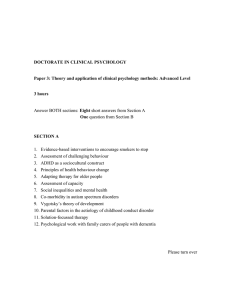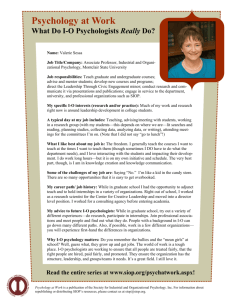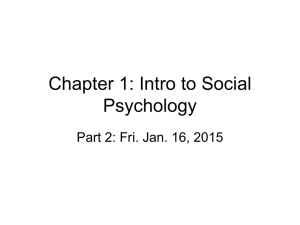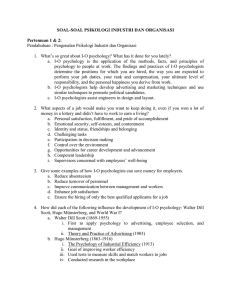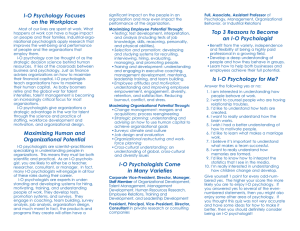SOAL-SOAL PSIKOLOGI INDUSTRI DAN ORGANISASI Pertemuan 26:
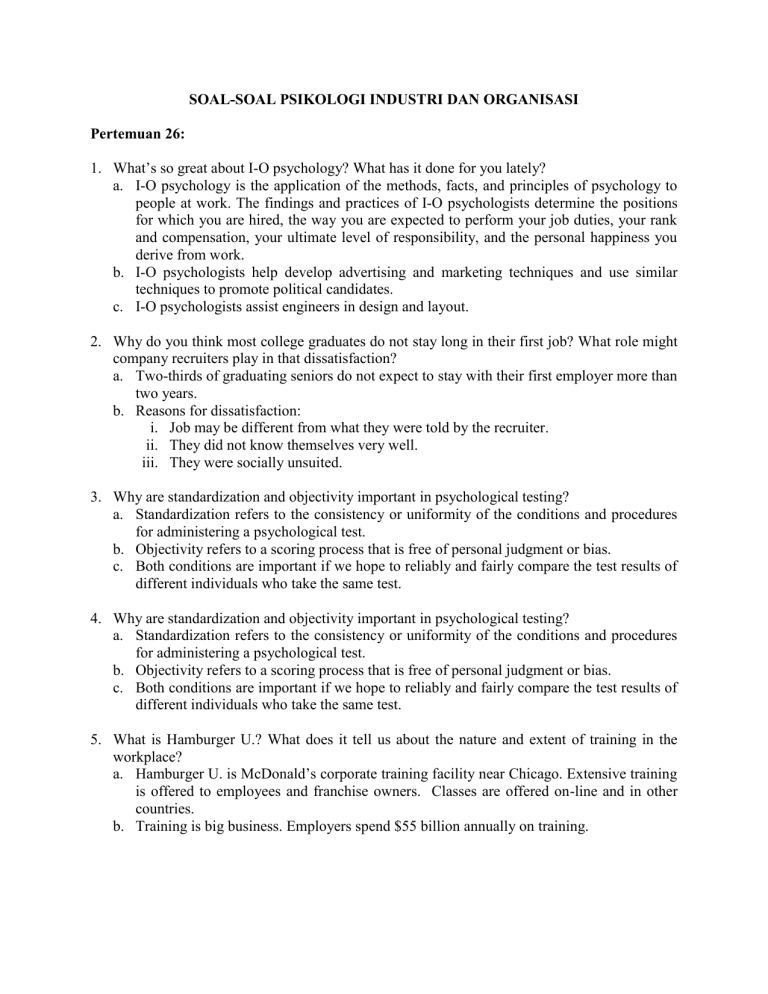
SOAL-SOAL PSIKOLOGI INDUSTRI DAN ORGANISASI
Pertemuan 26:
1.
What’s so great about I-O psychology? What has it done for you lately? a.
I-O psychology is the application of the methods, facts, and principles of psychology to people at work. The findings and practices of I-O psychologists determine the positions for which you are hired, the way you are expected to perform your job duties, your rank and compensation, your ultimate level of responsibility, and the personal happiness you derive from work. b.
I-O psychologists help develop advertising and marketing techniques and use similar techniques to promote political candidates. c.
I-O psychologists assist engineers in design and layout.
2.
Why do you think most college graduates do not stay long in their first job? What role might company recruiters play in that dissatisfaction? a.
Two-thirds of graduating seniors do not expect to stay with their first employer more than two years. b.
Reasons for dissatisfaction: i.
Job may be different from what they were told by the recruiter. ii.
They did not know themselves very well. iii.
They were socially unsuited.
3.
Why are standardization and objectivity important in psychological testing? a.
Standardization refers to the consistency or uniformity of the conditions and procedures for administering a psychological test. b.
Objectivity refers to a scoring process that is free of personal judgment or bias. c.
Both conditions are important if we hope to reliably and fairly compare the test results of different individuals who take the same test.
4.
Why are standardization and objectivity important in psychological testing? a.
Standardization refers to the consistency or uniformity of the conditions and procedures for administering a psychological test. b.
Objectivity refers to a scoring process that is free of personal judgment or bias. c.
Both conditions are important if we hope to reliably and fairly compare the test results of different individuals who take the same test.
5.
What is Hamburger U.? What does it tell us about the nature and extent of training in the workplace? a.
Hamburger U. is McDonald’s corporate training facility near Chicago. Extensive training is offered to employees and franchise owners. Classes are offered on-line and in other countries. b.
Training is big business. Employers spend $55 billion annually on training.
6.
In what ways are organizations and their employees affected by incompetent leaders and by abusive leaders? a.
Employees who face verbal abuse on the job develop anger and hatred toward their supervisors. They may resist their supervisors’ requests and demands, express low levels of job and life satisfaction, and behave in counterproductive ways. b.
Employees with a high level of trust report higher job satisfaction, performance, and commitment.
7.
Explain the differences between content theories and process theories of motivation. Give an example of each. What do these types of theories have in common? a.
Content theories focus on the importance of work itself, dealing with the specific needs that motivate and direct behavior. Maslow’s hierarchy of needs theory is one such example. b.
Process theories deal with the cognitive processes we use in making decisions and choices about our work. One example is the equity theory of motivation which addresses the issue of fairness and equity in receipt of outputs from work itself. c.
Content and process theories share the common goal of trying to explain why people behave the way they do at work.
8.
Why was the development of the bureaucratic organizational style considered to be such a revolutionary and humanistic change to the workplace? a.
Bureaucracy is a formal, orderly, and rational approach to organizing business enterprises. b.
It was designed to correct the inequities, favoritism, and cruelty during the era of the industrial revolution.
9.
Why is it difficult to interpret the effects of a change in the physical work environment that has led to an increase in productivity? a.
Productivity may increase at least temporarily, but it’s difficult to say what caused the increase. b.
Was it physical changes (climate-control, lighting, noise abatement) or was it psychological (attitude toward management)? c.
The effects of changes in physical working conditions may be influenced or modified by how employees perceive, accept, and adapt to these changes.
10.
In what ways can work affect your health? Give specific examples. a.
Work can affect your health through accidents, as the result of violence, through exposure to toxic chemicals, health issues associated with the use of equipment, and such special topics as HIV exposure, alcoholism, and drugs, all of which affect health. b.
Exposure to asbestos can lead to white-lung disease; accidents are the leading cause of death in the workplace, but murder is second.
11.
How can you tell when you are experiencing stress? Describe some of the mental and physical characteristics. a.
Stress is the physiological and psychological responses to excessive and usually unpleasant stimulation and to threatening events in the environment. b.
Stress-related physical problems include: high blood pressure, ulcers, colitis, heart disease, arthritis, skin diseases, allergies, headaches, neck and lower back pain, and cancer.
12.
Define ergonomics and describe its role and function in the workplace. a.
Ergonomics - the design of machines and equipment for human use, and the determination of the appropriate human behaviors for the efficient operation of the machines. The field is also called human factors, human engineering, and engineering psychology. b.
Its role and function in the workplace is the design of the machinery and equipment employees use to do their jobs and the workspaces in which those tasks are performed.
13.
What did John B. Watson contribute to the study of consumer behavior? a.
He founded the behaviorist school of psychology, and in 1921 applied his ideas about human behavior to problems in the business world. b.
He proposed that consumer behavior could be conditioned, predicted and controlled. He brought experimental and survey methods to marketing and insisted that advertisements focus on style and image, rather than substance and facts.
14.
Why would knowledge of psychological research methods be of value to you in your working career? a.
You will probably have to deal with the findings of I-O psychologists b.
To use their advice you must understand how they studied the problems and arrived at their conclusions c.
The goal is to acquaint you with the requirements, limitations, and methods of the scientific approach.
